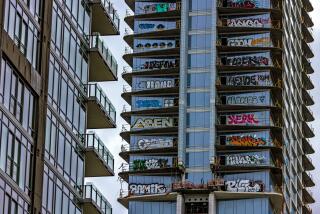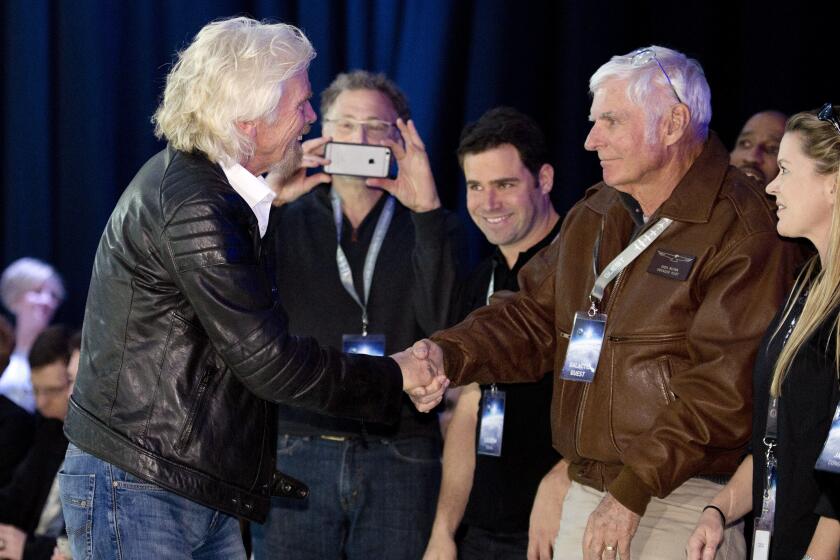Casino Builder Plays High-Stakes Game
Master resort builder Steve Wynn has little patience for people who get in his way.
Stephanie Swain has dared to, and now may be paying for it.
She lives in Desert Inn Country Club Estates -- once one of the most prestigious and pampered residential addresses in Las Vegas, home to doctors and lawyers, entertainers and executives, politicians and mobsters. Today she is one of 10 remaining homeowners who have refused to sell their homes to Wynn to make room for his new resort hotel and adjoining golf course.
Earth movers already have begun churning up parts of the site’s existing golf course, revamping it for the resort. Wynn said he plans to simply work around the 10 homes that sit alongside the distant fairways.
“For years, it was like we were living in Central Park, next door to the Tavern on the Green,” said Swain, the widow of a former casino executive who was one of the estate’s first homeowners in 1959. “If [Wynn] continues at this [development] pace, he’ll make these homes uninhabitable.”
So be it, says Wynn, because what’s at stake is the $2-billion, 45-story, 2,700-room Le Reve, expected to be the most extravagant and expensive resort along the already over-the-top Strip. When it opens in spring 2005, the resort will feature, among other highlights, a Ferrari and Maserati dealership, a fine-arts gallery featuring Picasso’s Le Reve (“The Dream”) and a tree-topped mountain nearly 100 feet high that will teasingly shield the hotel from the Strip and serve as a backdrop for elaborate water and light shows for its guests.
The project is so highly anticipated here -- Las Vegas’ economy is driven by resort construction -- that both of Nevada’s U.S. senators attended Le Reve’s Oct. 31 groundbreaking and sung Wynn’s praises.
For two years, Swain and other homeowners have been slapping Wynn with lawsuits in an attempt to protect their homes and what remains of their neighborhood. In the end, the remaining homes may end up sandwiched between the existing brick walls that block busy streets 50 feet away and 20-foot-high landscaped berms being raised behind their backyards to add dramatic topography to the links. A greenskeeper’s maintenance shed also may be constructed alongside one of the homes.
“I don’t need her property. I don’t want her property,” Wynn said of Swain. “We’ll build the golf course around it. We can do anything we want with the [remaining] property. We own it and have the zoning.”
Wynn has a history of overcoming such obstructions -- one way or another. When he bought land to build the side-by-side Mirage and Treasure Island hotels, Wynn refused to pay an apartment building owner the “gazillions of dollars” he said the man demanded for his property on the site. So Wynn built around it and today the apartment building is incongruously surrounded by parking structures and asphalt.
In a deposition for the homeowners’ lawsuits, Wynn said the apartment owner -- and now the homeowners alongside his golf course -- are “a perfect example of blind greed, that if [a developer] with money is your next-door neighbor, there must be a way to shake him down for the bread.”
To build his new resort, Wynn bought the once-distinguished but tired Desert Inn casino, resort and golf course for about $270 million in 2000. It’s his first major project since selling his Mirage Resorts casino corporation. While its chairman, he became the most important developer of Strip hotels.
There was some early outcry when he announced that he would buy the properties adjoining the Desert Inn golf course and reconfigure the land for the new resort, but most of the acquisitions went smoothly.
Among 60 homes, 29 already were owned by the Desert Inn and included in the sale to Wynn. Fifteen homes were critical to Wynn because they were along a cul-de-sac that penetrated the golf course. He offered each homeowner $2 million, and each accepted.
He told the remaining homeowners along the periphery of the course that he would pay them 10% more than the higher of two appraisals of their homes. All but 10 agreed, and theirs are the only homes still standing today.
Wynn said that he offered Swain a fair price for her house and that Swain demanded much more. Swain acknowledges that she would sell if the price was right, but won’t discuss details.
Among the issues in the pending lawsuits is whether Wynn, by purchasing most of the homes in the subdivision, now controls its homeowners association. The matter won’t reach a judge until spring. Making such a claim, Wynn has discontinued street cleaning and landscaping of what little common grass areas still exist. The homeowners can claim at least one small victory, however: A court decision forced Wynn to help pay for the neighborhood’s guarded gate, which he had tried to dismantle.
Wynn’s chief counsel, Marc Rubinstein, considers the homeowners’ allegations a moot issue, in any event, because the residents concede that Wynn now owns the golf course, which they had enjoyed for its lush greenery just a block off the Strip.
As construction gets underway, Swain and the others decry the erection of a fence that they say maliciously blocks their views. Rubinstein says the fence is required for safety.
Some homeowners worry now that they’ve run out of options. “He’s not buying any more houses,” said Sharon Greenbaum, who recalls the days of living near Bobby Vinton, Engelbert Humperdinck, Louis Prima, Harry James and Betty Grable. “This used to be such a prestigious neighborhood, just a block off the Strip.”
Swain, who serves as the neighborhood spokeswoman, said she doesn’t object to having Le Reve as a neighbor. “I wouldn’t mind staying here and having Le Reve as a neighbor,” Swain said. “But I don’t want to lose my view or our amenities,” she said. “Steve Wynn has forced me into a corner.”






